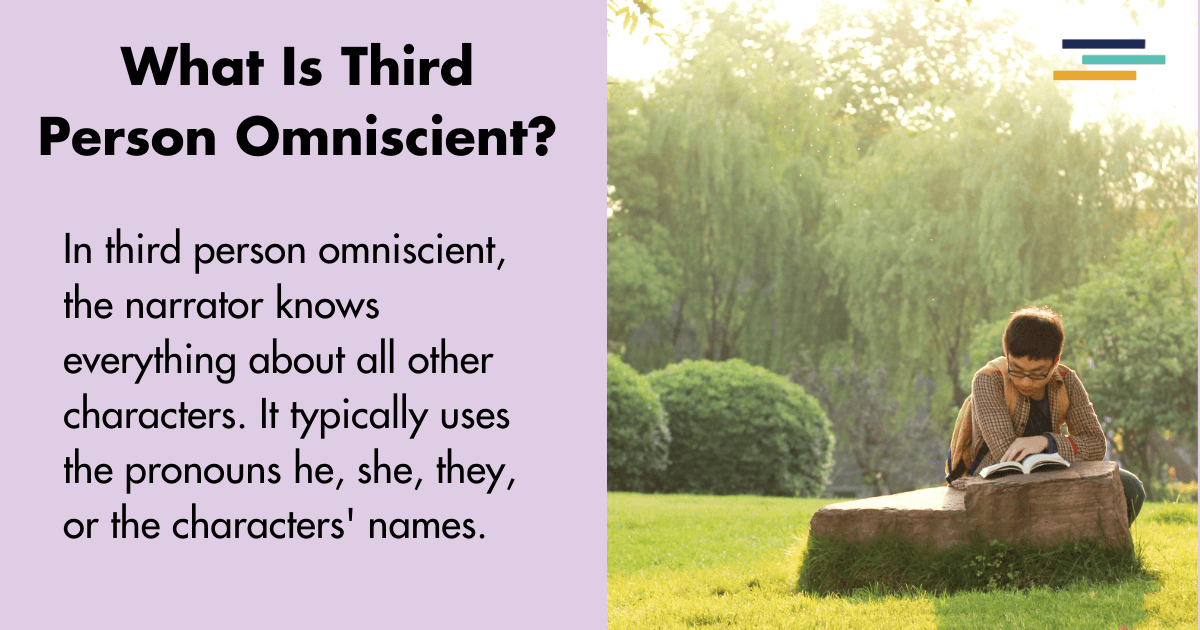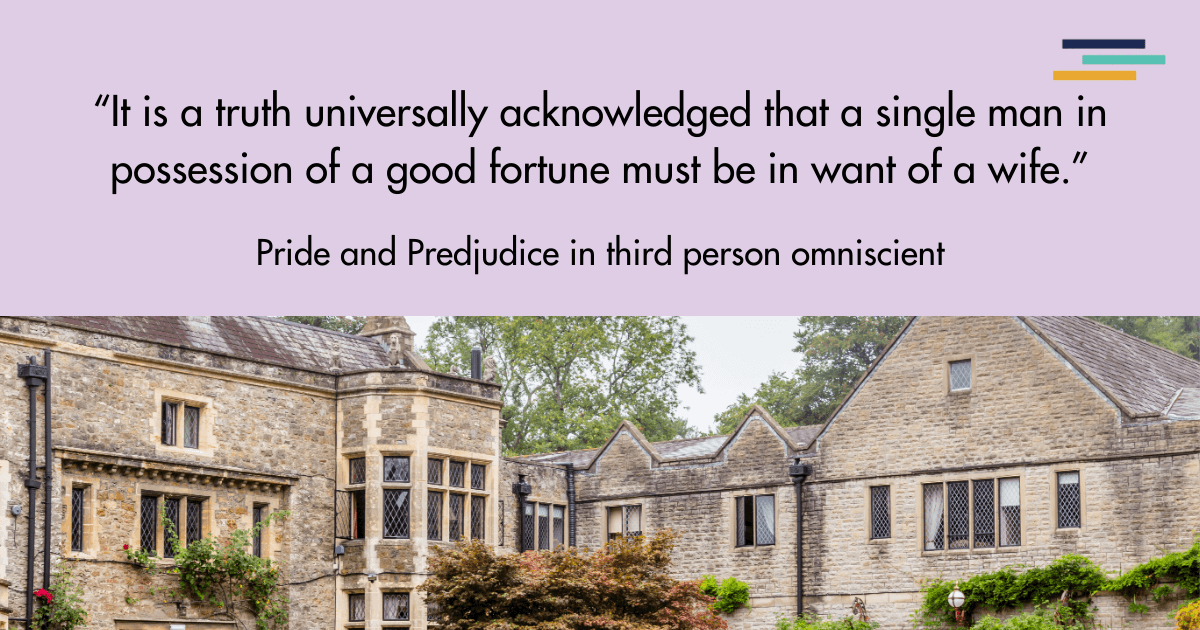 Third person omniscient, is told from a (usually) uninvolved observer, or narrator, who can know what all the characters think and do and even know about events the characters are not directly involved in.
Third person omniscient, is told from a (usually) uninvolved observer, or narrator, who can know what all the characters think and do and even know about events the characters are not directly involved in.
Omniscient means all knowing. It derives from the prefix omni, meaning all, and the Latin scire meaning knowledge.
In this articles, we are going to delve deeper into what third person omniscient is, some example of it in popular books, and tips for writing it.
What is Third Person Omniscient Point of View (POV)?
Third omniscient point of view is one of many point of views a writer can choose from.
In this POV, the narrator knows everything, including thoughts, feelings, and actions, about all other characters. It typically uses the pronouns he, she, they, or the characters’ names.
Why Write in Third Person Omniscient Point of View?
Here are a few of the benefits of writing in third person omniscient:
- Third omniscient uses an uninvolved narrator, but this does not mean that the narrator is flat or boring. The narrator maintains a uniform narrative voice. The narrative voice is one of the most powerful storytelling tools because it evokes the tribal, community, elder storytelling tradition. It is the original “Once upon a time.”
- Third omniscient provides narrative distance for stories about large, overarching ideas, generational issues, universal concepts, or societal conflicts.
- A third omniscient narrator can teach or analyze the action or emotion, without the need for long descriptions to show the action. With large volumes of information, such as world-building, the need to show can slow the pace and increase the word count.
- If your story needs frequent shortcuts for movement, time passing, imparting lots of current information, or important backstory, you should consider third omniscient.
- You can vary your degree of omniscience. Maybe the narrator knows all about the protagonist’s group but not anything about another.
- It flexes your writing and creative muscles. It requires thinking and composing in a way that is different from your everyday experience.
- Third omniscient can be used to solve POV problems that appear in other POV uses. For example, if you are having difficulty with a single character third limited, try writing the scene from third omniscient. Looking at your current story with a scene in another POV, can illuminate subtle POV issues.

How to Choose Third Person Omniscient Point of View
If you are considering using third person omniscient point of view, you should first ask yourself the following questions:
- If you want an immediacy and closeness, third omniscient might not be the best choice. The narrative distance can stand in between the story and the reader.
- The purpose of the story should be best suited to a narrator and not an involved character.
- The story should require the reader to have the whole picture the entire time. The reader will feel you cheated if you withhold information. Unless, of course, you are using the deception or the unreliability of the narrator as a specific device.
- If tension or suspense are important to your story, third omniscient will be a bit more difficult due to the all-knowing narrator. You will not be able to have situations where one character knows something that another does not. You will not be able to use mystery as easily. You would just use the narrator to imply tension or to tell the reader something none of the characters know or use actual conflict more often.
Is Third Person Omniscient Point of View Easy to Write?
You’ve probably heard third omniscient is difficult to write and even more difficult to write well. Here are a few reasons for this difficulty:
- It requires a uniform presentation, consistency, and careful information sculpting. When you have access to all information, as an omniscient narrator would, it is easy to become overwhelmed by what you want to impart to the reader. It can lead to surface characters or events because the writer may feel a push to summarize in order to include all information.
- There are two types of Omniscience: objective and subjective.The objective is camera-like, reporting what it sees, and it does not include the thoughts of characters, only their dialogue and actions. Most times, if third omniscient is discussed, it is referring to the subjective, narrative voice.The subjective is an observer and possesses the narrative voice.
- The reading culture tends to prefer closer, more immediate relationship with characters.
- Third omniscient is difficult to write because it is not a natural state of awareness for humans.
Third Person Omniscient Point of View vs Third Person Limited Point of View
Both third person omniscient and third limited are written in third person, so they use the same pronouns.
Third person limited has one character POV at a time. It uses a similar idea to third omniscient where more than one POV is accessed, but it provides a closer tie between character and reader by using limited third.
Third person limited is perhaps easier to follow as well, due to the tendency to switch POV by scene or chapter rather than ad lib as with third omniscient.
Third Person Omniscient Point of View Examples
The Scarlet Letter, Nathaniel Hawthorne
An example of third omniscient being used to address a societal concept, the book’s second paragraph states: “The founders of a new colony, whatever Utopia of human virtue and happiness they might originally project, have invariably recognized it among their earliest practical necessities to allot a portion of the virgin soil as a cemetery, and another portion as the site of a prison.”
Peter Pan, James Barrie
The very first line of this book establishes the third omniscient: “All children, except one, grow up.” Only an omniscient narrator would know this to be a truth.
Pride and Prejudice, Jane Austen
Another example of the third omniscient is evident from the first line, “It is a truth universally acknowledged that a single man in possession of a good fortune must be in want of a wife.”
Third omniscient tends to use truth as its springboard. stablishing a narrator as all-knowing is easily done by declaring a truth. Look for these statements in the beginning of stories and you may find third omniscient.

How to Write in Third Person Omniscient Point of View
Decide on Your Omniscience
Decide on your omniscience as an objective camera or a subjective narrator. Usually only one is chosen,. Remember that the camera perspective relies on showing and does not include character thoughts. If you decide on the subjective, readers will follow that voice wherever it leads them.
Build Your Scenes
Allow me a more visual, but imperfect analogy for this step:
- Before you begin building your scene, start by imagining the characters sitting in a circle as in the children’s game, Duck Duck Goose.
- Your third omniscient narrator is the player who rounds the outside, tapping each player, on the head.
- Your narrator is not in the circle. They are outside, looking in, but they are in control of the action or the movement of the story.
Clearly Separate Different Perspectives
Consider how your narrator will tell the story. Think about breaking each perspective into paragraphs or groups of paragraphs so that the movement from character to narrator comment or from character to character is clear. It is cleaner to break the perspectives into scenes, but it can be done at the inter-scene level if care is taken to be clear.
One perspective per scene or even per chapter is also possible.
How to Evaluate Third Person Omniscient Point of View Using the Fictionary Elements
One set of the 38 Fictionary Elements is The Character Elements. These come in to play with a third omniscient narrator in Fictionary. You will use them a bit differently than you would with other POV’s, and this is shown and explained below.
Step 1
In the Journey section, choose the Cast of Characters and Add Character. Enter Third OM Narrator (or whatever you would like to call the Narrator). Then click Set as Single POV Character, then Save.
Step 2
In the Evaluate section, choose the Character Elements on the right side of the screen. Your POV should auto populate with Third OM Narrator (or your chosen Narrator name).
Step 3
Track POV Goal as either Scene Goal External or Protagonist Goal External.
Step 4
Track POV Goal Internal as either Scene Goal Internal or Protagonist Goal Internal.
Step 5
Impact on POV Character can be disregarded as the Third Omniscient is not involved in the goals and outcomes of the story.
Step 6
POV Knowledge Gained can be disregarded as the Third Omniscient is already all-knowing and shouldn’t be learning something during the story.
Step 7
Still in the Evaluate section, but under the Plot heading, use Reader Knowledge Gained to assure that the reader knows what the Narrator would know and that you are strategic in any non-disclosure of information.
Final Thoughts on Using Third Person Omniscient Point of View
There is a difference between liking to read third omniscient and liking to write third omniscient.
As a literary girl who has read many classics, I would say I love reading it. As a writer, I would have to say it’s not my first choice. Either that or I haven’t had any large, overarching ideas, generational issues, universal concepts, or societal conflicts to write about.
I’ve used third omniscient in a few short stories, but I have yet to try it for a novel. Maybe I’ll challenge myself on my next one.
If you are writing in third omniscient, I salute you, and may I recommend you use Fictionary, which is perfectly set up to assist with the elements you need to create and manage your great third omniscient POV story.


